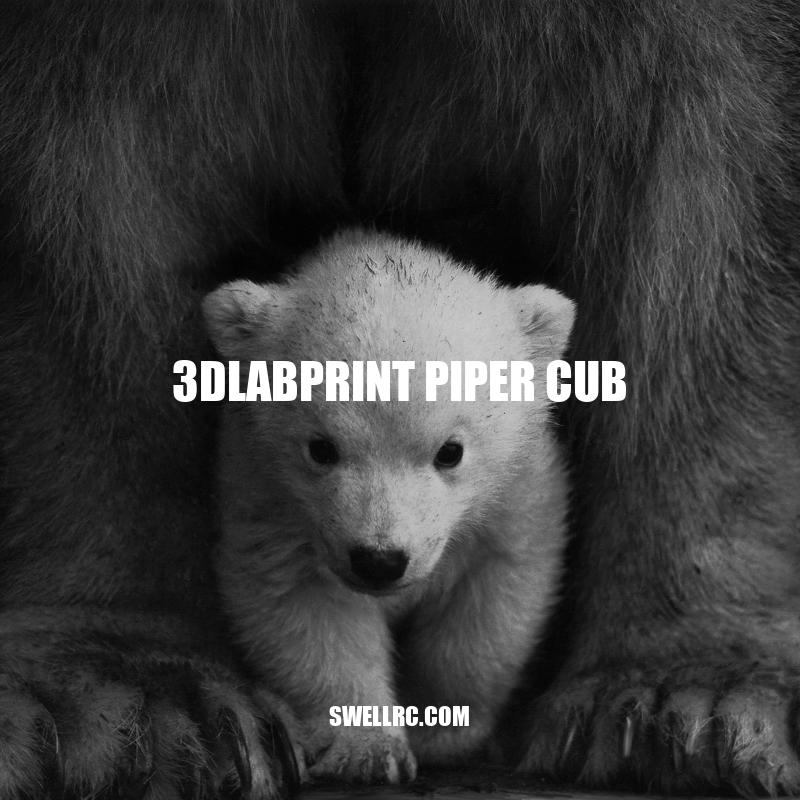3D Printed Scale Model Airplane: 3dlabprint Piper Cub
The 3dlabprint Piper Cub is a remarkable and affordable 3D-printed scale model airplane. It offers a perfect solution for hobbyists who love aviation and want to replicate a classic 1940’s aircraft. With the advancements in 3D printing technology, it has become possible to create this airplane at home without spending a fortune. The model airplane has a 1400mm wingspan and weighs around 2.2 kgs. It can be printed with PLA or PETG filament, which are both durable materials used in the aviation industry. The Piper Cub model has an intricately designed exterior with smooth curves that brings this vintage plane to life, offering an exciting and challenging project for aviation enthusiasts of all levels. With the 3D-printed parts, building the Piper Cub is a rewarding and enjoyable experience.
Specifications and Features of the 3dlabprint Piper Cub
- The 3dlabprint Piper Cub is designed for 3D printing with your own 3D printer.
- The model airplane comes in kit form and consists of approximately 70 parts that can be printed in around 50 hours on an average 3D printer.
- The downloadable STL files are available at a cost of €49.90 on the 3dlabprint website.
- The kit comes with pre-cut balsa wood strips for the leading edge of the wings, fuselage and tail, and includes other hardware such as carbon fiber rods for the wing spar.
- The Piper Cub is a three-channel control airplane, which means it requires three servos, one for the ailerons, one for the elevator and one for the rudder.
The Piper Cub is a great introduction to 3D printing and RC flying. With its detailed design and numerous features, building and flying this 3D-printed airplane will provide hours of entertainment for aviation enthusiasts. The next section will cover how to assemble the 3dlabprint Piper Cub upon completion of the 3D printing process.
What type of aircraft is a Piper Cub?
The Piper Cub is a light single-engine monoplane designed for flight training, touring, and personal use. Here are some quick facts about the Piper Cub:
- It was first produced in 1937
- The original model was designated the J-2, but it evolved into the J-3 and later the PA-18
- The original design had an open cockpit and was used extensively in World War II for scouting and observation
- Today, the Piper Cub is a beloved vintage aircraft and popular for recreational flying
For more information about the history and technical details of the Piper Cub, check out aviation websites or books, such as “The Piper Cub: Story of a Legend” by Roger Guillemette.
Assembly of 3dlabprint Piper Cub
Begin by sorting all the printed parts carefully and marking them for easy identification.
Start assembling the fuselage by joining the printed parts using the included balsa wood strips and by cutting and trimming as necessary.
Connect the servos to the control surfaces and join the wing and tail sections to the fuselage.
Install the radio receiver and battery, making sure to balance the aircraft correctly.
Refer to the assembly guide, which is available on the 3dlabprint website along with detailed instructions, photos and videos.
While the assembly of the 3dlabprint Piper Cub requires attention to detail and a certain level of skill, it is also an exciting and rewarding experience. It is important to note that the assembly of the Piper Cub could take anywhere between 16 to 24 hours, depending on your skill level, so make sure you have adequate time and patience before beginning. The next section will cover the flight capabilities of the 3dlabprint Piper Cub.
What is the difference between a Piper Cub and a Super Cub?
- The Piper Cub was first introduced in 1937, while the Super Cub came out in 1949.
- The Super Cub has a more powerful engine and can carry more weight than the original Cub.
- The Super Cub also has a longer wingspan and a larger rudder, providing better stability and control during flight.
- Overall, the Super Cub is an upgraded version of the original Piper Cub with more capabilities and improved performance.
If you are interested in learning more about Piper aircraft, you can visit their official website at https://www.piper.com/.
Flight Capabilities of the 3dlabprint Piper Cub
The 3dlabprint Piper Cub is a great model for those new to 3D printed model airplanes, or even those with some previous experience. It boasts a range of impressive features that make it a fun and exciting model to fly:
- Average flying speed of 20-25 km/h
- Stable and consistent flight performance
- Can perform a range of aerobatics
- Long flying time of 20-25 minutes
- Can be easily controlled using a standard 2-3 channel radio
The 3dlabprint Piper Cub comes pre-configured with a flat-bottom airfoil that provides good lift and stability. It also features flaps that can be adjusted mid-flight to enhance performance. While the model is suitable for flying in a range of conditions, it is best flown in calm weather to help maximize its performance.
While the 3dlabprint Piper Cub is relatively easy to fly, it is important to note that you will need to have some previous experience with radio-controlled model aircraft before attempting to fly this model. It is recommended that you practice with a more basic model before moving on to the Piper Cub.
How much does a Piper Cub cost?
Here are the approximate costs for a new and used Piper Cub as of 2021:
- New Piper Cub: $64,900 – $122,000
- Used Piper Cub: $25,000 – $70,000
Please note that the price can vary based on the model, age, condition, and location of the aircraft. For more detailed information and to see current listings, visit websites such as Controller.com or Trade-A-Plane.com.
Benefits of 3D Printing in Aviation
3D printing technology has revolutionized the field of aviation. Here are some key benefits of 3D printing in aviation:
- Cost-effectiveness: 3D printing has significantly reduced the cost of manufacturing parts and components.
- Flexibility: 3D printing allows for the creation of complex geometries and shapes that are not possible with traditional methods.
- Accuracy: 3D printing technology ensures high precision and accuracy in the final product.
- Speed: 3D printing can reduce production time from weeks to days or even hours.
3D printing technology has also made it possible to create lighter, stronger, and more durable parts and components for aircraft. With this technology, engineers and manufacturers can create parts with increased fatigue resistance, improved mechanical properties, and reduced weight, thereby improving an aircraft’s performance.
3D printing has already been used successfully in aviation for the creation of parts such as engine components, air ducts, brackets, and more. The technology is expected to play a significant role in the future of aviation, with more and more parts being 3D printed as the technology continues to evolve.
Why is 3D printing a good choice for aviation?
- 3D printing allows for faster, more efficient production of complex parts, reducing production times and costs.
- The technique of using 3D printing can create parts with improved durability and strength, as well as making parts lighter, leading to cost savings due to the reduction in fuel costs.
- 3D printing offers more flexibility in design, allowing for faster design iterations and the creation of more optimized parts.
- 3D printing can also help aviation companies reduce their overall environmental impact by reducing waste and increasing the use of sustainable materials like bioplastics and recycled materials.
If you want to learn more about the benefits of 3D printing in aviation, you can visit the website of industry leaders in 3D printing services, like Stratasys Direct Manufacturing or Materialise.
Conclusion
The 3dlabprint Piper Cub is a great example of how 3D printing technology can be used to create intricate and detailed scale model airplanes. With its unique features and advantages, the 3dlabprint Piper Cub is a must-have for aviation enthusiasts and model airplane collectors.
3D printing has transformed the field of aviation, making it possible to create lighter, stronger, and more durable parts and components for aircraft. The technology has also revolutionized the way new aircraft designs are developed and tested, enabling engineers to quickly create and test prototypes.
As 3D printing technology continues to evolve, it is bound to play an even bigger role in aviation. With its cost-effectiveness, flexibility, accuracy, and speed, 3D printing is quickly becoming the preferred method of manufacturing parts and components in the aviation industry.
So whether you are an aviation enthusiast or a manufacturer looking to revolutionize your production process, 3D printing is definitely a technology worth exploring. The possibilities are endless!



